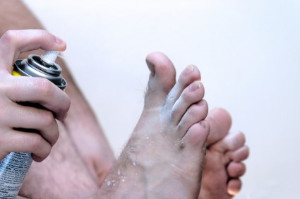 Tinea pedis, also known as a fungal infection of the foot, or athlete’s foot, is a very common condition. One health expert estimates that between 15 and 25 percent of people will get athlete’s foot at some point in their life. With new fashion trends like going sockless while wearing shoes, cases of athlete’s foot are increasing according to experts in the UK. Though this increase in the number of cases has been largely among men, women can also contract athlete’s foot at high rates. Fungus thrives in moist, dark, and warm places, similar to the environment inside of a shoe. Socks are important because they help to wick away moisture and keep the feet dry. If you prefer to wear shoes without socks, make sure to wash your feet everyday and to let your shoes air out. Furthermore, avoid going barefoot in public showers, locker rooms, and gyms; these places can harbor not only fungus, but also bacteria and viruses which can affect your feet. While generally not a serious condition, chronic athlete’s foot can be treated by a podiatrist.
Tinea pedis, also known as a fungal infection of the foot, or athlete’s foot, is a very common condition. One health expert estimates that between 15 and 25 percent of people will get athlete’s foot at some point in their life. With new fashion trends like going sockless while wearing shoes, cases of athlete’s foot are increasing according to experts in the UK. Though this increase in the number of cases has been largely among men, women can also contract athlete’s foot at high rates. Fungus thrives in moist, dark, and warm places, similar to the environment inside of a shoe. Socks are important because they help to wick away moisture and keep the feet dry. If you prefer to wear shoes without socks, make sure to wash your feet everyday and to let your shoes air out. Furthermore, avoid going barefoot in public showers, locker rooms, and gyms; these places can harbor not only fungus, but also bacteria and viruses which can affect your feet. While generally not a serious condition, chronic athlete’s foot can be treated by a podiatrist.
Athlete’s foot is an inconvenient condition that can be easily reduced with the proper treatment. If you have any concerns about your feet and ankles, contact one of our podiatrists from The Podiatry Center, PC. Our doctors will treat your foot and ankle needs.
Athlete’s Foot: The Sole Story
Athlete's foot, also known as tinea pedis, can be an extremely contagious foot infection. It is commonly contracted in public changing areas and bathrooms, dormitory style living quarters, around locker rooms and public swimming pools, or anywhere your feet often come into contact with other people.
Solutions to Combat Athlete’s Foot
- Hydrate your feet by using lotion
- Exfoliate
- Buff off nails
- Use of anti-fungal products
- Examine your feet and visit your doctor if any suspicious blisters or cuts develop
Athlete’s foot can cause many irritating symptoms such as dry and flaking skin, itching, and redness. Some more severe symptoms can include bleeding and cracked skin, intense itching and burning, and even pain when walking. In the worst cases, Athlete’s foot can cause blistering as well. Speak to your podiatrist for a better understanding of the different causes of Athlete’s foot, as well as help in determining which treatment options are best for you.
If you have any questions please feel free to contact our office located in Millburn, NJ. We offer the newest diagnostic and treatment technologies for all your foot and ankle needs.
Read more about Athlete's Foot